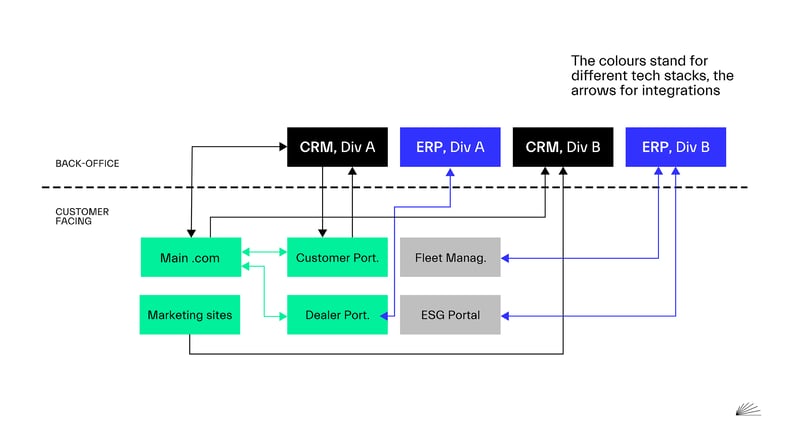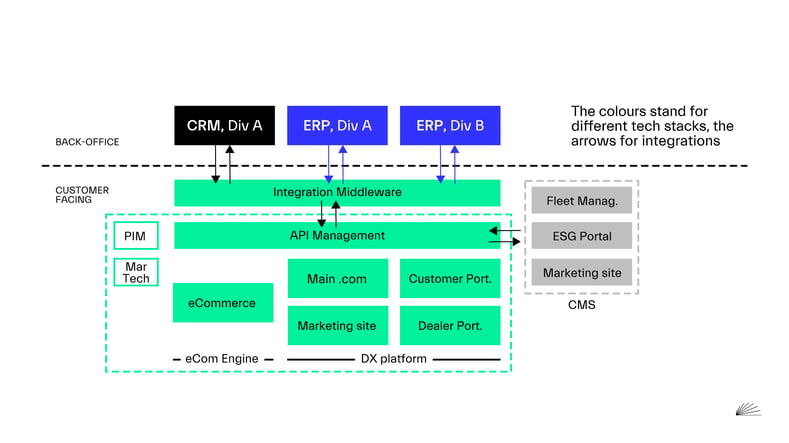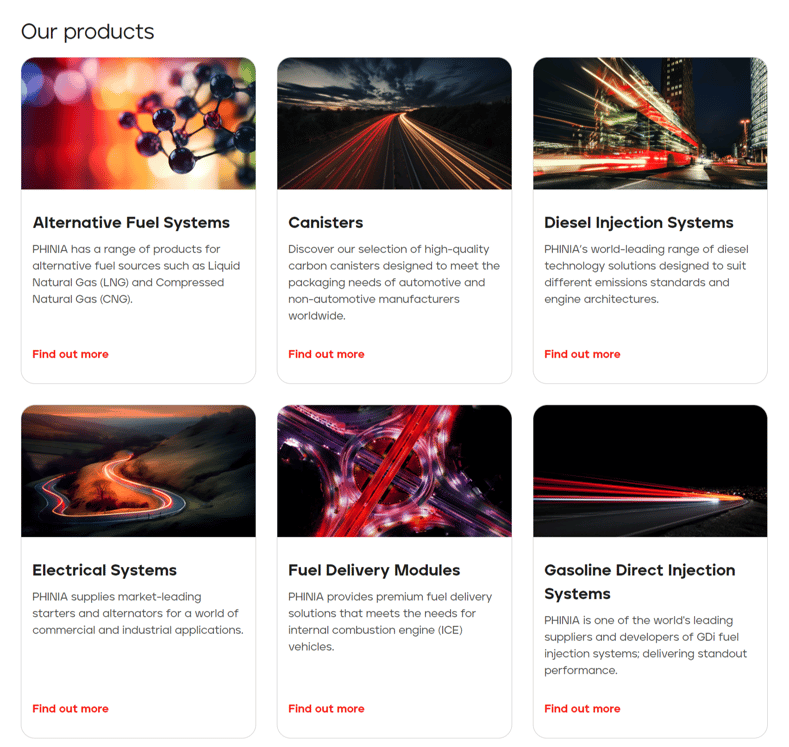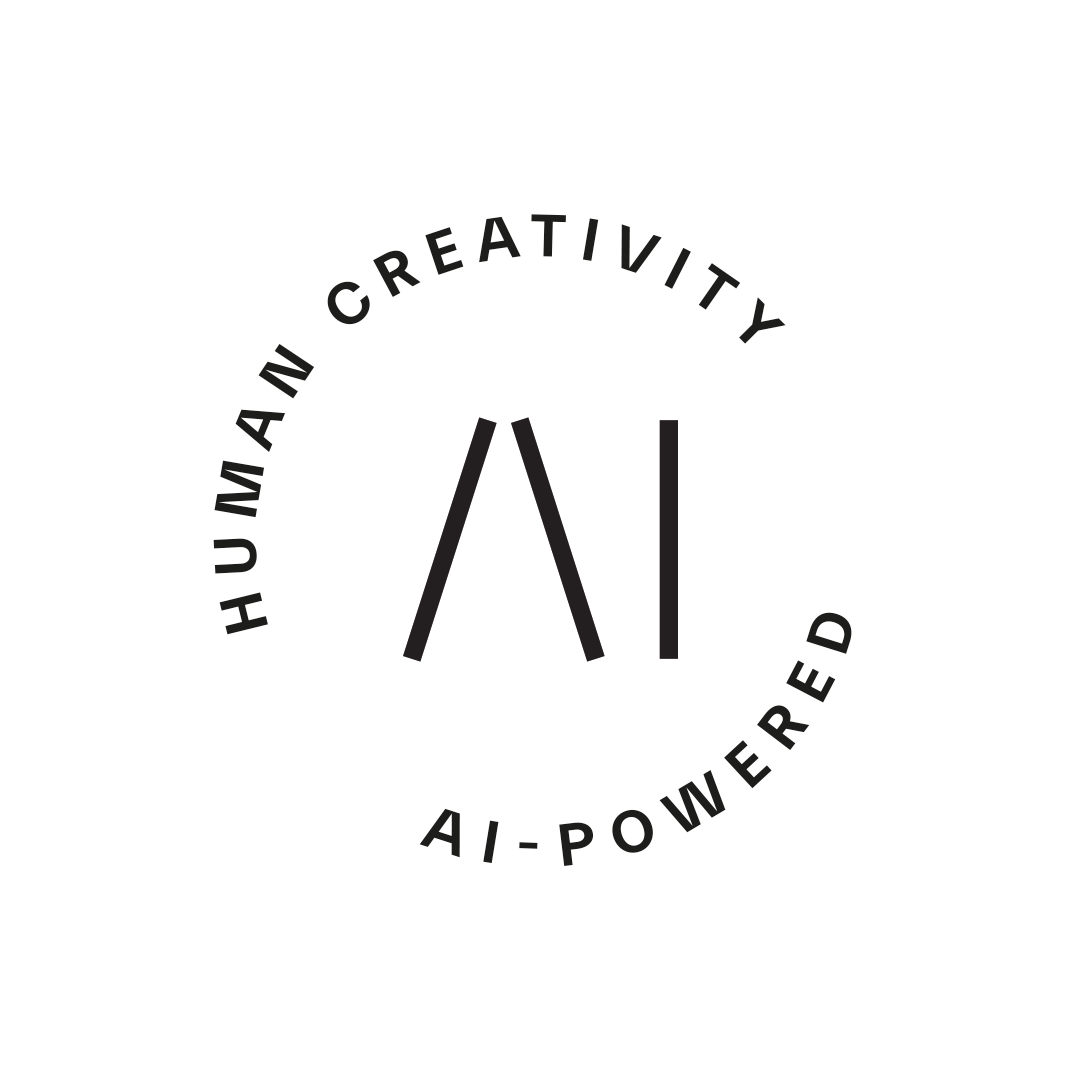Three years ago, in our 'Decade of Digital Experiences' webinar, we discussed how leading brands like Tesla and Netflix were setting new standards for B2B digital experiences. The terms 'reasonable' and 'functional' no longer fully capture what customers expect from B2B user experiences.
Nowadays, customers anticipate an experience that not only meets functional and accessibility standards but also creates a 'wow' effect. This expectation comes despite budget constraints, and with a 30% lower budget than the last renewal.
1. Design once, use throughout the customer’s experience
Is meeting these new standards with fewer resources unrealistic and unachievable? It would be if you attempted to mimic the approach used by top consumer brands to develop their billion-user platforms, or if you followed the same strategy as in your last B2B service overhaul. However, achieving these heightened expectations requires innovative thinking and a fresh approach.
In this scenario, efficiency is key, necessitating an atomic design approach that integrates all assets into a well-managed design system alongside a component library. By adopting this strategy, costly design investments are made once, but pay dividends repeatedly. You can craft new components effortlessly by using these foundational elements—atoms, molecules, and organisms. Additionally, the component library is crucial in maintaining consistent UX across various digital touchpoints, including websites, portals, and apps, regardless of whether they share the same platform.
2. Consolidate your platform portfolio in a business-case driven way
To achieve the light and appealing UX, it's essential to apply the same principles to your back office and deal with the clutter hindering the development of your digital experience platform.
Despite the need for efficiency, it's common for companies, including yours, to have overlapping systems. This often stems from company expansions, such as acquiring new brands, which brings in an array of systems, from ERPs and CRMs to DXPs. Managing user experience across these disparate systems is not only costly but also creates a bottleneck. It hinders the efficient collection of crucial product and customer data scattered across these platforms.

Image: A typical scenario in a multidivisional corporation.
In addressing this integration challenge, traditional strategies like forced adoption and co-existence fall short. Forced adoption, where acquired brands must conform to the existing technology stack, can sometimes benefit smaller entities by providing structure. However, this often results in a loss of valuable flexibility. On the other hand, the co-existence approach, which leaves different systems intact and operating side by side, typically leads to inefficiency, increased costs, and data silos.
A contemporary solution involves a business-case-driven consolidation, aligning with modern composable platform development. Begin with the customer interface, such as the Digital Experience Platform (DXP), and progressively integrate back-end systems. Leveraging Product Information Management (PIM) systems, whether standalone products or DXP extensions, facilitates the unification of product data from diverse sources. This strategy not only streamlines operations but also facilitates eCommerce capabilities, providing an added advantage.
There is no need to migrate all your brands to your main digital experience platform (DXP) all at once. Modern DXPs are designed to handle multiple data sources, including content management systems (CMS) or other DXPs from your existing brands. Start by integrating these data sources to centralize data collection. Then, transition your brands to the main DXP incrementally, based on strategic business needs. This could be driven by the requirement for new functionalities that are unavailable in the current CMS but offered by your main DXP, or by the need to improve cross-brand lead generation and e-commerce capabilities.
The ultimate objective is to have a single digital experience platform (DXP) that supports all your brands. This includes their websites, apps, self-service portals, and more, all utilizing shared components – but with a branded UXs. 
Image: A ‘good enough’ target scenario for a consolidation effort.
Design the UX once, but brand the visuals individually for all your brands to keep the brand identity. Apply the same principle to feature development – develop once, brand for all. This way you can achieve savings up to 30-50% when counting in development, maintenance, and license costs.
If your DXP does not support this, you need to consider another product.
3. Ecommerce capabilities are a must
A traditional eCommerce approach might not be fitting if your products are big, customized, and expensive. However, you can still enhance the purchasing experience of your customers by ensuring that your product information is easily accessible, and a clear purchase path is established on your website. For consumables, spare parts and add-on products, a traditional web-shop solution is typically a well-suited option.

Image: A product listing example from Phinia.com.
Even if you have a reliable partner network that handles your sales channels and you are satisfied with this arrangement, it's crucial not to neglect your websites and customer portals. It's essential to centralize all product data, making it easily accessible to both customers and partners. In this scenario, your site should include a 'where to buy' feature, guiding customers directly to a shopping cart on your preferred partner’s web shop. This can be managed either by automatically directing customers based on pre-defined business logic or by allowing customers to view their options and choose the partner themselves.
In self-service portals, eCommerce activities require even greater attention. Since this is where your users are already identified and authenticated, they anticipate a user experience (UX) tailored specifically to their needs. The portal should emulate a knowledgeable salesperson, familiar with the user's complete sales history, product inventory, and requirements. Users expect the portal to not only display their full sales history but to leverage this information to recommend the optimal timing and quantities for consumables and spare parts across various locations.
Recommendations should be based on actual usage data of the fleet—whether it is composed of ships, vehicles, printing machines, or any type of machinery. Moreover, the portal should present related products that are genuinely relevant to the customer's specific needs, rather than generic options that might feel irrelevant or pushy. This approach ensures the recommendations feel personalized and valuable, fostering a positive customer experience and engagement.
4. Move from request-driven customer communication towards automated and predictive fleet management
Many businesses find it challenging to encourage their customers to use self-service options. This difficulty often arises when the service is not user-friendly or fails to truly empower users beyond merely viewing information they've already obtained through other channels. To overcome this, it's crucial to give your customers more control: allow them to export data, build their own reports, and compare their business to their (anonymized) peers’ performance. This way they will want to come to your online self-service.
5. Use GenAI in web presence and self-service
There are multiple ways you can utilize the benefits of Large Language Models (LLM) and Generative AI in your web presence and self-service. Start your experimentation where there already is some experience available, such as in advanced chat bots advising your users to pick the optimal product or to get help in using your products. You might also want to use the power of LLMs in the background processing feedback, invoices, emails, and other non-structured data.
Use caution when generating content with GenAI—hallucination could potentially harm your credibility. Instead of solely relying on GenAI for final outputs, incorporate it into your content creation process—including translations—to enhance efficiency, ensuring that a human reviews the content before it goes live. A prudent first step in integrating GenAI into your operations could involve using it to summarize longer texts and perform automatic categorization.
Advanced search functionalities with a conversational user interface are also something worth experimenting with. This approach can significantly enhance your self-service options, transforming it into a powerful knowledge base. It empowers users to leverage the full potential of the available data.
Let’s not forget about co-pilots assisting the actual coding of the solution. If your team or vendor is not using such tooling—start the discussion and find a way of moving forward that is compliant with your data privacy policies.
6. Keep the running costs reasonable and your service robust
Using multiple systems brings multiple licensing, development, and maintenance costs. However, there are more actions you can take beyond just the consolidation mentioned earlier. A robust and resilient platform is one that operates at low running costs. Moreover, a robust platform won't frustrate your users with delays and bugs. In today's digital age, where your online services act as your storefront, a slow and buggy UX equates to offering disrespectful and unreliable customer service.
First, build in the robustness. In development, be strict about security, coding practices, automated testing, as well as about truthful and trustful communication with and within the development team. The focus should not be on the quantity of features delivered but on delivering the most valuable features in a manner that is usable by end-users and content creators. Ensure these features are reusable across all your brands, websites, and apps.
Second, build your platform so that it can scale up and down. Paying extra just for preparedness is not an effective cloud computing strategy. Cloud services should be coupled with proper monitoring to allow you to scale up during high load periods and down during low load periods to reduce costs. However, optimization development costs can exceed potential computing savings, so ensure you don’t spend more on optimization than you would save on computing. Sometimes, transferring platform operational risks to a service provider can be the most cost-effective option. In the DXP world, almost all major platforms offer a Platform as a Service (PaaS) option worth exploring for this reason.
Third, your service's maintenance philosophy can be the most impactful factor. ITIL is fine, but it often focuses maintenance on managing tickets, detaching service development from maintenance. This can cause indifference on both sides due to misaligned interests. Luckily, developers tend to embrace a DevOps mindset – taking a holistic "develop for maintainability and resilience" approach.
The best practice for maintaining any service is Site Reliability Engineering (SRE). This combines the DevOps developer mindset with thorough monitoring, auto-scaling, and error recovery. The goal is to minimize human interference to keep systems running smoothly. SRE accepts that bugs will occur but requires that bug fixes are accompanied by improved monitoring to catch similar events in the future. It also mandates that error handling procedures be coupled to bugs whenever possible and safe.
Solutions nowadays should be resilient enough to run at close to 100% up-time – if yours is not, take immediate action.
Writer
Matti Kiviluoto, Team Builder at Siili Solutions | Blogger at OurGreatTeam.com
LinkedIn: @mattikiviluoto

